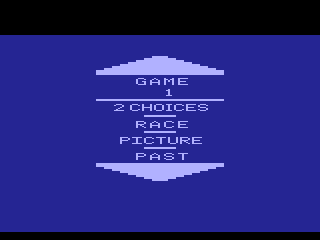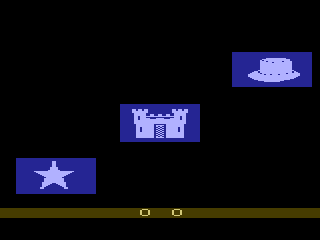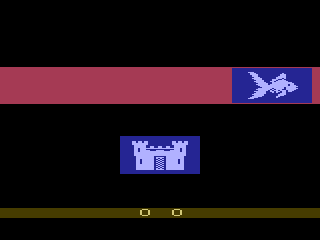|
|
Mind Maze
|
Name:
|
Mind Maze |
|
| Company: | Atari | |
|
Model #:
|
N/A | |
|
Programmers:
|
Garry Shannon (Programmer) and Howard Scott Warshaw (Designer) | |
| Year: | 1983 | |
|
Released?
|
No
|
|
|
Notes:
|
Originally called Mind Race |
A game based on ESP? Yep you heard me right, Mind Maze is the first (and only) Atari game to be based on the unproven (yet still popular) theory of ESP (Extra Sensory Perception). It appears Atari was attempting to develop a sort of "Mind Reading" game for its new Mindlink controller. So can the 2600 really read your thoughts? Read on to find out...
Mind Maze is played somewhat like those old mind reading experiments where a scientist would hold up a card and ask a person to tell him what was on the other side. Depending on the game selected, two to four cards appear on the screen each round. The player then must try and guess the "correct" card by highlighting it (using the joystick) and pressing the fire button. Unfortunately this is where the game begins to fall apart. As you've probably guessed the theory of ESP is pretty far fetched, and the odds that the player can continually guess the correct card is slim. So the player must simply sit there and randomly select cards until he by chance selects the correct one. Predictably, this gets boring very fast...
After choosing a card all but one of the card pictures will disappear, and the computer will then highlight the "correct" card on the screen. If the player is playing with the "Race" option, the game will show a solid blue screen and wait for the player to press a button before continuing to the next round. This blue screen (which probably would have been spruced up for the final release) is simply used to allow the other player to get ready for his turn. The player may also "pass" on the current set of cards by pressing the button without selecting a card. This will cause a new set of cards to appear but it will still be the players turn. There doesn't seem to be a limit on the number of times you can pass, but the game will not advance until the player picks a card.
The current score is shown at the bottom of the screen. The left digit appears to be the players score, while the right digit is the computer/opponents score. The first player to reach 20 points wins the game, after which you're returned to the main screen. By setting the right difficulty switch to B, the player can activate the "Cheat" mode. When the cheat mode is activated selecting any card will score the player points (thus making the game completely pointless). When the switch is put back in A position the scoring is set back to normal (as normal as scoring gets in this game anyway). The cheat mode was probably put in by the programmer to help the ESP challenged debug the game.
As I mentioned earlier, Mind Maze appears to have several options which can be set for each game. The main screen lists four options: # of Choices (2, 3, or 4), Race/No Race, Picture/Color, and Past/Future.
| # of Choices | This sets the number of cards that appears on the screen. The game defaults to two choices, but can be set as high as four. Obviously the more choices there are, the harder the game becomes. |
| Race/No Race | This option is for setting up a two player "race" game. The only visible effect this option seems to have is activating or deactivating the blue screen. Setting the game to 'Race' causes the solid blue screen to appear between rounds, while setting it to 'No Race' skips this screen. This blue screen is for indicating when one player's turn ends, and the others begins. |
| Picture/Color |
This option affects the cards themselves. Selecting 'Picture' will cause the game to display a series of beautiful pictures on the cards (everything from castles to goldfish), while selecting color will replace these pictures with a block of solid color. When playing the 'Color' game, the picture actually hides behind one of the cards and is not visible to the player. Selecting one of the cards will cause the picture to be revealed and the game will proceed to the next round (after awarding the appropriate points). |
| Past/Future | Out of all the options in the game, this one is the strangest. As the name suggests this option affects the order in which players try to predict the cards (trying to guess the card that was just played or the card about to be played). If set to Past the 2600 will select the "correct" card before the player chooses. If the option is set to Future the 2600 will select the correct card as the player chooses. |
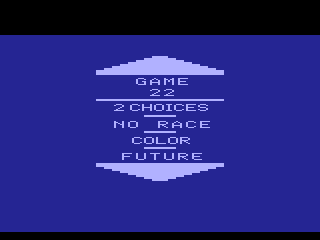
Unlike more advanced 2600 games such as Motorodeo, the player cannot actually change the game options directly. Instead the player must keep selecting game numbers until the combination of rules he wants is found. Since there are four different options (one with three choices), there are a whopping 24 different game variations in this prototype (3*2*2*2). Not too shabby for a game from 1984.
If you haven't already noticed by the screenshots, the graphics in Mind Maze are absolutely gorgeous. Each picture is large and well detailed (a rarity on the 2600). The graphics also have a really cool 'Fade In' effect that adds a bit of eye candy to an otherwise drab looking game. Excellent graphics in a game so early in the development cycle are rare, as the programmer usually put bland 'placeholder' graphics in until the gameplay was finished. One has to wonder what other little surprises the programmer had in store for us.
Although Mind Maze is constantly listed as being a Mindlink game, this prototype doesn't actually have any code in it to support the controller. However according to the programmers, Mind Maze was definitely meant to be a Mindlink game. Supposedly the headband was to read the players Alpha and Beta waves in an attempt to help predict their actions. However since the Mindlink was really just a sensor that detected muscle movements in the players forehead, this was complete bunk. The whole mind reading idea was just another angle thought up by Atari's marketing department.
So why was Mind Maze cancelled? According to programmer Garry Shannon:
"Physicist and ESP researcher Russel Targ, and "psychic" author Keith Harary came to Atari and pitched the idea to a group of programmers and managers. I got picked to be on the team and had a few more meetings with the pair working out design details. I remained skeptical, but thought it might be a fun game anyway. But as it turns out, the pair knew nothing about designing a fun game, and I knew nothing about "ESP", so the design ideas were pretty dismal. Sadly, there didn't seem to be any way to make it either fun or interesting. After a couple months of programming and experimenting it was dropped. I was glad to let it go."
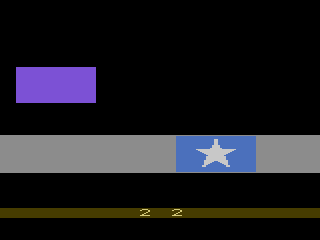
Although the theory behind Mind Maze was pretty far out there, it does show just how far Atari was willing to go to develop games for its new Mindlink controller. Mind Maze was ultimately scrapped due to to the limited appeal of the "game" (or perhaps the marketing department finally stopped smoking those funny little cigarettes). However Mind Maze would not be the last game to dabble in the paranormal, several years later another mind reading game called "Taboo: The Sixth Sense" was released for the NES. Taboo was pretty much laughed off the store shelves and faded into obscurity, so it appears that Atari made the right decision after all.
| Version | Cart Text | Description |
| 10/10/83 | Mind Maze 10-10 | Only prototype known to exist |

